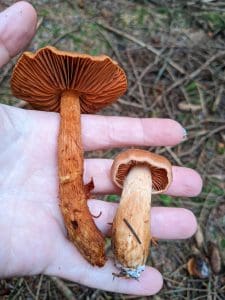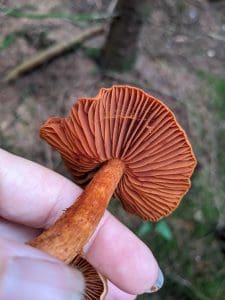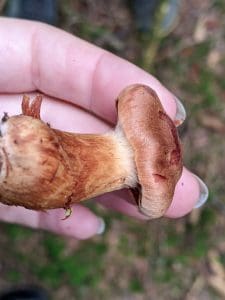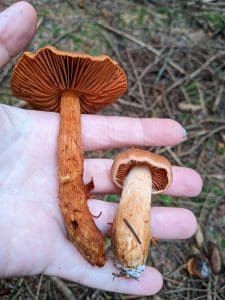Deadly Webcap / Summer / Autumn / Winter / Deadly Toxic
The Deadly Webcap (Cortinarius rubellus) is one of the most dangerous mushrooms found in the UK, European and North American forests.
With its deceptively ordinary appearance, this species has been responsible for numerous cases of severe poisoning and fatalities. The mushroom’s reddish-brown cap and rusty gills might not appear particularly menacing, but they conceal a potent toxin known as orellanine.
This compound can cause severe kidney damage, often leading to renal failure if not treated promptly. The delayed onset of symptoms, which can take days to manifest, makes the Deadly Webcap particularly treacherous, as victims may not immediately associate their illness with mushroom consumption.
In this article, we will explore the identifying features of the Deadly Webcap, the nature of its toxicity, and the critical importance of avoiding this lethal fungus while foraging.
Common Name
Deadly Webcap
Scientific Name
Cortinarius rubellus
Family
Cortinariceae
Deadly Webcap Mushroom Identification Video
Habitat
Late summer- early winter
With coniferous woodland- Mycorrhizal with conifers partially pine and spruce. Likes soil that is acidic and damp.
Appears in groups, sometimes in large numbers.
Very rare south, but incredibly common in Scotland and northern Europe.
Identifying Features
Cap
Convex with an in-rolled margin at first, flattening out to a bell shape (campanulate) with a central umbo.
Tawny orange-brown in colour, becoming more of a rust brown with age. Lighter on the rim.
Texture is dry, matt and lightly fibrous. With age the edges of the cap become irregular.

Stem
5-10 cm usually a little uneven or tapering with a bulbous base
Yellow, orange and rusty colours, usually a mixture of all three in a snake skin like pattern.
No persistent skirt, but can have remnants of the cortina or a ring of a rusty brown spore deposits.
Gills & Underside
Key identifier is the cortina, web-like fibres that cover the gills when young.
Gills are an orange yellow when young becoming a rust brown. Intermediate shorter gills


Smell:
Slight smell of radish
Spores
Rusty red brown
Known hazards
This deadly poisonous species can cause serious kidney and liver damage just from even a small piece.
Contains a toxin called orellanine, also in many other webcaps. Orellanine causes fatal kidney and liver failure but symptoms don’t appear until 2-3 days after ingestion, initially with flu-like symptoms, sickness and headaches at which point may already be too late. Only with very fast intensive medical treatment might someone survive.
The Deadly Webcap (Cortinarius rubellus) contains a highly toxic compound called orellanine, which is responsible for its lethal effects. Orellanine is a bipyridine-like toxin that primarily targets the kidneys, leading to severe nephrotoxicity (kidney damage). What makes orellanine particularly dangerous is the delayed onset of symptoms, which can occur anywhere from two days to three weeks after ingestion. This delay often prevents timely medical intervention and makes it difficult to link symptoms to the mushroom consumption.
The symptoms of orellanine poisoning begin with nonspecific flu-like signs, such as headaches, vomiting, and abdominal pain. As the toxin progresses, it leads to more severe effects such as kidney failure, which can be irreversible without medical treatment, including dialysis or a kidney transplant.
For more detailed information on orellanine and its effects, you can consult resources such as the National Poisons Information Service (NPIS) and detailed fungal toxicology studies available via PubMed.
Additionally, the NHS provides guidance on symptoms and treatment related to mushroom poisoning, including those involving toxic compounds like orellanine found in the Deadly Webcap.
Potential lookalikes
Other webcaps of a similar colour such as Cortinarius orellanus
Extra notes from the foragers
A mushroom with a cortina (webbing under the cap), rusty coloured gills and a rusty colour ring zone all point to having found a webcap. This family contains predominantly very toxic fungi, so with these features you can ID as a web cap and avoid all of them.
This fungi exhibits as a great example of what to avoid more broadly also, it would serve any forager well (unless an expert) to be highly cautious of any mushroom with a rusty brown underside.
Not only the webcaps display this feature, there are many other fungi that have a rusty brown underside and they are nearly all poisonous. Some other examples are- rust-gills, deadly galerina, cinnamon bracket and cone caps.






